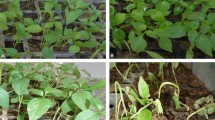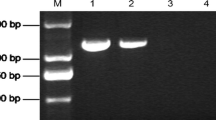Abstract
Invasive phytoplasmas wreak havoc on coconut palms worldwide, leading to high loss of income, food insecurity and extreme poverty of farmers in producing countries. Phytoplasmas as strictly biotrophic insect-transmitted bacterial pathogens instigate distinct changes in developmental processes and defence responses of the infected plants and manipulate plants to their own advantage; however, little is known about the cellular and molecular mechanisms underlying host–phytoplasma interactions. Further, phytoplasma-mediated transcriptional alterations in coconut palm genes have not yet been identified. This study evaluated the whole transcriptome profiles of naturally infected leaves of Cocos nucifera ecotype Malayan Red Dwarf in response to yellow decline phytoplasma from group 16SrXIV, using RNA-Seq technique. Transcriptomics-based analysis reported here identified genes involved in coconut innate immunity. The number of down-regulated genes in response to phytoplasma infection exceeded the number of genes up-regulated. Of the 39,873 differentially expressed unigenes, 21,860 unigenes were suppressed and 18,013 were induced following infection. Comparative analysis revealed that genes associated with defence signalling against biotic stimuli were significantly overexpressed in phytoplasma-infected leaves versus healthy coconut leaves. Genes involving cell rescue and defence, cellular transport, oxidative stress, hormone stimulus and metabolism, photosynthesis reduction, transcription and biosynthesis of secondary metabolites were differentially represented. Our transcriptome analysis unveiled a core set of genes associated with defence of coconut in response to phytoplasma attack, although several novel defence response candidate genes with unknown function have also been identified. This study constitutes valuable sequence resource for uncovering the resistance genes and/or susceptibility genes which can be used as genetic tools in disease resistance breeding.





Similar content being viewed by others
References
Albertazzi G, Milc J, Caffagni A, Francia E, Roncaglia E et al (2009) Gene expression in grapevine cultivars in response to Bois Noir phytoplasma infection. Plant Sci 176:792–804
Altschul SF, Gish W, Miller W, Myers EW, Lipman DJ (1990) Basic local alignment search tool. J Mol Biol 215:403–410
Barakat A, DiLoreto DS, Zhang Y, Smith C, Baier K et al (2009) Comparison of the transcriptomes of American chestnut (Castanea dentata) and Chinese chestnut (Castanea mollissima) in response to the chestnut blight infection. BMC Plant Biol 9:51
Bertaccini A, Duduk B, Paltrinieri S, Contaldo N (2014) Phytoplasmas and phytoplasma diseases: a severe threat to agriculture. Am J Plant Sci 5:1763–1788
Bilgin DD, Zavala JA, Zhu J, Clough SJ, Ort DR et al (2010) Biotic stress globally downregulates photosynthesis genes. Plant, Cell Environ 33:1597–1613
Boyd LA, Ridout C, ÓSullivan DM, Leach JE, Leung H (2013) Plant–pathogen interactions: disease resistance in modern agriculture. Trends Genet 29:233–240
Broschat TK, Harrison NA, Donselman H (2002) Losses to lethal yellowing cast doubt on coconut cultivar resistance. Palms 46:185–189
Curković PM (2008) Auxin-treatment induces recovery of phytoplasma-infected periwinkle. J Appl Microbiol 105:1826–1834
Deng S, Hiruki C (1991) Amplification of 16S rRNA genes from culturable and non culturable mollicutes. J Microbiol Methods 14:53–61
Ding Y, Wei W, Wu W, Davis RE, Jiang Y et al (2013a) Role of gibberellic acid in tomato defence against potato purple top phytoplasma infection. Ann Appl Biol 162:191–199
Ding Y, Wu W, Wei W, Davis RE, Lee I-M et al (2013b) Potato purple top phytoplasma-induced disruption of gibberellins homeostasis in tomato plants. Ann Appl Biol 162:131–139
Du Toit A (2014) Phytoplasma converts plants into zombies. Nat Rev Microbiol 12:393
Du Z, Zhou X, Ling Y, Zhang Z, Su Z (2010) AgriGO: a GO analysis toolkit for the agricultural community. Nucleic Acids Res 38(Web Server issue):W64–W70
Ebrahim S, Usha K, Singh B (2011) Pathogenesis related (PR) proteins in plant defense mechanism. In: Méndez-Vilas A (ed) Science against microbial pathogens: communicating current research and technological advances, vol 2. Formatex Research Center, Badajoz, pp 1043–1054
Etalo DW, Stulemeijer IJ, van Esse HP, de Vos RC, Bouwmeester HJ et al (2013) System-wide hypersensitive response-associated transcriptome and metabolome reprogramming in tomato. Plant Physiol 62:1599–1617
Eulgem T, Somssich IE (2007) Networks of WRKY transcription factors in defense signaling. Curr Opin Plant Biol 10:366–371
Goeck J, Nekrutenko A, Taylor J (2010) The Galaxy Team. Galaxy: a comprehensive approach for supporting accessible, reproducible, and transparent computational research in the life science. Genome Biol 11:R86
Gundersen DE, Lee I-M (1996) Ultrasensitive detection of phytoplasma by nested-PCR assays using two universal primer sets. Phytopathol Mediterr 35:144–151
Hogenhout S, Oshima K, Ammar ED, Kakizawa S, Kingdom H et al (2008) Phytoplasmas: bacteria that manipulate plants and insects. Mol Plant Pathol 9:403–423
Hoshi A, Oshima K, Kakizawa S, Ishii Y, Ozeki J, Hashimoto M et al (2009) A unique virulence factor for proliferation and dwarfism in plants identified from a phytopathogenic bacterium. Proc Natl Acad Sci USA 106:6416–6421
Hren M, Nikolić P, Rotter A, Blejec A, Terrier N et al (2009) “Bois noir” phytoplasma induces significant reprogramming of the leaf transcriptome in the field grown grapevine. BMC Genom 10:460
IRPCM Phytoplasma/Spiroplasma Working Team-Phytoplasma taxonomy group (2004) “Candidatus Phytoplasma”, a taxon for the wall-less, non-helical prokaryotes that colonize plant phloem and insects. Int J Syst Evol Microbiol 54:1243–1255
Jaeger PA, Doherty C, Ideker T (2012) Modeling transcriptome dynamics in a complex world. Cell 151:1161–1162
Jones JDG, Dang JL (2006) The plant immune system. Nature 444:323–329
Li H, Durbin R (2009) Fast and accurate short read alignment with Burrows–Wheeler transform. Bioinformatics 14:1754–1760
Liu R, Dong Y, Fan G, Zhao Z, Deng M et al (2013) Discovery of genes related to witches broom disease in Paulownia tomentosa × Paulownia fortunei by a de novo assembled transcriptome. PLoS ONE 8(11):e80238
Liu LY, Tseng HI, Lin CP, Lin YY, Huang YH, Ck Huang, Chang TH, Lin SS (2014) High-throughput transcriptome analysis of the leafy flower transition of Catharanthus roseus induced by peanut witches’-broom phytoplasma infection. Plant Cell Physiol 55:942–957
Maejima K, Oshima K, Namba S (2014) Exploring the phytoplasmas, plant pathogenic bacteria. J Gen Plant Pathol 80:210–221
Mou H-Q, Lu J, Zhu S-F, Lin C-L, Tian G-Z et al (2013) Transcriptomic analysis of Paulownia infected by paulownia witches’-broom Phytoplasma. PLoS ONE 8(10):e77217
Naderali N, Nejat N, Tan YH, Vadamalai G (2013) First report of two distinct phytoplasma species, Candidatus Phytoplasma cynodontis and Candidatus Phytoplasma asteris, simultaneously associated with yellow decline of Wodyetia bifurcata (foxtail palm) in Malaysia. Plant Dis 97:1504
Nagano AJ, Sato Y, Mihara M, Antonio BA, Motoyama R, Itoh H, Nagamura Y, Izawa T (2012) Deciphering and prediction of transcriptome dynamics under fluctuating field conditions. Cell 151:1358–1369
Nejat N, Tan YH (2014) Genome plasticity in obligate parasitic phytoplasmas. In: Katsy E (ed) Plasticity in plant-growth-promoting and phytopathogenic bacteria. Springer, New York, pp 155–169
Nejat N, Vadamalai G (2010) Phytoplasma detection in coconut palm and other tropical crops. Plant Pathol J 9:101–110
Nejat N, Vadamalai G (2013) Diagnostic techniques for detection of phytoplasma diseases: past and present. J Plant Dis Protect 120:16–25
Nejat N, Sijam K, Abdullah SNA, Vadamalai G, Dickinson M (2009a) Molecular characterization of a phytoplasma associated with coconut yellow decline (CYD) in Malaysia. Am J Appl Sci 6:1331–1340
Nejat N, Sijam K, Abdullah SNA, Vadamalai G, Dickinson M (2009b) Phytoplasmas associated with disease of coconut in Malaysia: phylogenetic groups and host plant species. Plant Pathol 58:1152–1160
Nejat N, Valdiani A, Cahill D, Tan Y-H, Maziah M, Abiri R (2015) Ornamental exterior versus therapeutic interior of Madagascar periwinkle (Catharanthus roseus): the two faces of a versatile herb. Sci World J ID: 982412, 19
Nicaise V, Roux M, Zipfel C (2009) Recent advances in PAMP-triggered immunity against bacteria: pattern recognition receptors watch over and raise the alarm. Plant Physiol 150:1638–1647
Novák J, Pavlů J, Novák O, Nožková-Hlávčková V, Špundová M et al (2013) High cytokinin levels induce a hypersensitive-like response in tobacco. Ann Bot 112:41–55
Ooka H, Satoh K, Doi K, Nagata T, Otomo Y et al (2003) Comprehensive analysis of NAC family genes in Oryza sativa and Arabidopsis thaliana. DNA Res 10:239–247
Piffanelli P, Zhou F, Casias C, Orme J, Jarosch B et al (2002) The barley MLO modulator of defense and cell death is responsive to biotic and abiotic stress stimuli. Plant Physiol 129:1076–1085
Qi X, Bakht S, Qin B, Leggett M, Hemmings A et al (2006) A different function for a member of an ancient and highly conserved cytochrome P450 family: from essential sterols to plant defense. Proc Natl Acad Sci USA 103:18848–18853
Robinson MD, McCarthy DJ, Smyth GK (2010) edgeR: a Bioconductor package for differential expression analysis of digital gene expression data. Bioinformatics 26:139–140
Santi S, Grisan S, Pierasco A, De Marco F, Mosetti R (2013) Laser microdissection of grapevine leaf phloem infected by stolbur reveals site-specific gene responses associated to sucrose transport and metabolism. Plant, Cell Environ 36:343–355
Schneider B, Seemüller E, Smart CD, Kirkpatrick BC (1995) Phylogenetic classification of plant pathogenic mycoplasma-like organisms or phytoplasmas. In: Razin R, Tully JG (eds) Molecular and diagnostic procedures in mycoplasmology. Academic Press, San Diego, pp s 369–s 380
Sugio A, Hogenhout SA (2012) The genome biology of phytoplasma: modulators of plants and insects. Curr Opin Microbiol 15:247–254
Thomas SG, Phillips AL, Hedden P (1999) Molecular cloning and functional expression of gibberellins 2-oxidases, multifunctional enzymes involved in gibberellins deactivation. Proc Natl Acad Sci USA 96:4698–4703
Ward ER, Payne GB, Moyer MB, Williams SC, Dincher SS et al (1991) Differential regulation of beta-1,3-glucanase messenger RNAs in response to pathogen infection. Plant Physiol 96:390–397
Wei W, Davis RE, Nuss DL, Zhao Y (2013) Phytoplasmal infection derails genetically preprogrammed meristem fate and alters plant architecture. Proc Natl Acad Sci USA 110:19149–19154
Winkel-Shirley B (2002) Biosynthesis of flavonoids and effects of stress. Curr Opin Plant Biol 5:218–223
Xia W, Liu Z, Yang Y, Xiao Y, Mason AS et al (2014) Selection of reference genes for quantitative real-time PCR in Cocos nucifera during abiotic stress. Botany 92:179–186
Ye J, Coulouris G, Zaretskaya I, Cutcutache I, Rozen S et al (2012) Primer-BLAST: a tool to design target-specific primers for polymerase chain reaction. BMC Bioinform 13:134
Zhao Y, Davis RE, Wei W, Lee IM (2015) Should ‘Candidatus Phytoplasma’ be retained within the order Acholeplasmatales? Int J Syst Evol Microbiol. doi:10.1099/ijs.0.000050
Acknowledgments
The authors would like to acknowledge the University of Putra, Malaysia, for supporting this project.
Conflict of interest
The authors declare that they have no conflict of interest.
Ethical standard
This article does not contain any studies with human participants or animals performed by any of the authors.
Author information
Authors and Affiliations
Corresponding author
Additional information
Communicated by B. Yang.
Electronic supplementary material
Below is the link to the electronic supplementary material.
Rights and permissions
About this article
Cite this article
Nejat, N., Cahill, D.M., Vadamalai, G. et al. Transcriptomics-based analysis using RNA-Seq of the coconut (Cocos nucifera) leaf in response to yellow decline phytoplasma infection. Mol Genet Genomics 290, 1899–1910 (2015). https://doi.org/10.1007/s00438-015-1046-2
Received:
Accepted:
Published:
Issue Date:
DOI: https://doi.org/10.1007/s00438-015-1046-2




